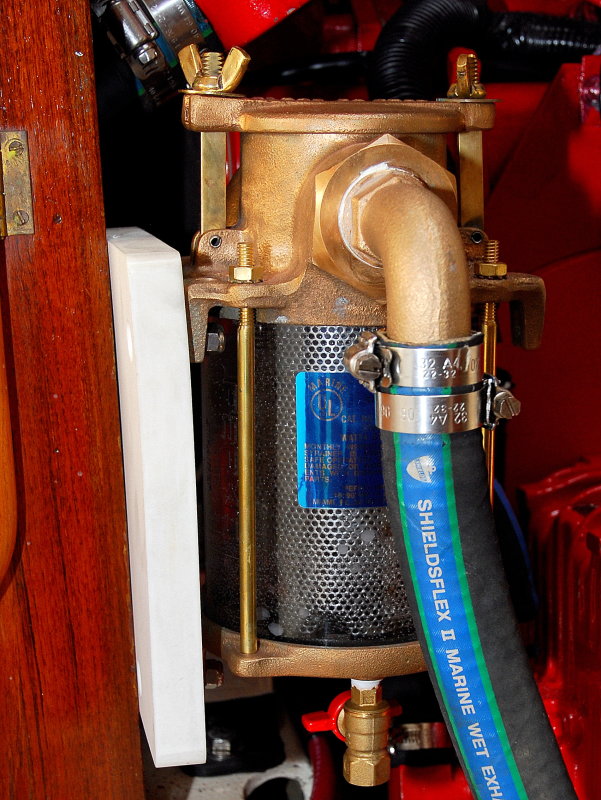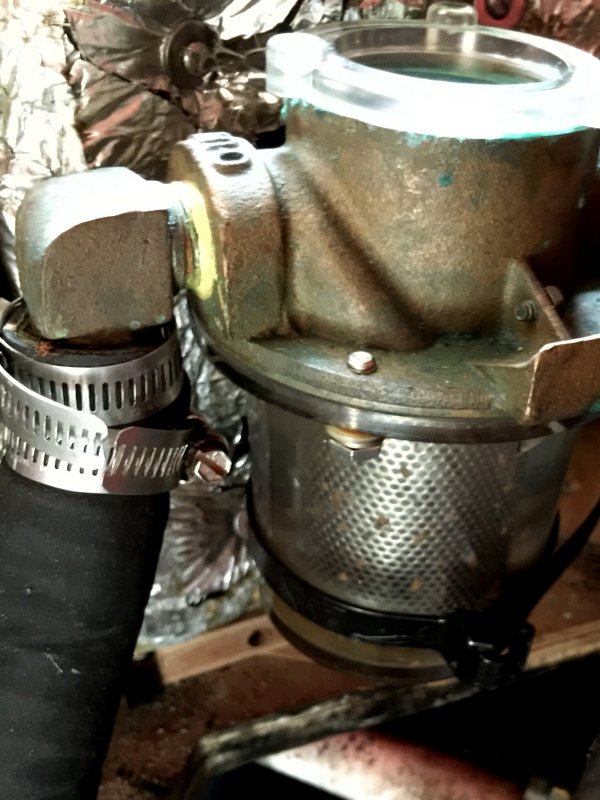
“RC My Engine is Overheating?”
Over the years I have really grown to distrust and dislike external intake strainers of either the scoop type or the non directional (sailboat style) round type. The real danger in these devices comes when you have a blockage and can’t get to the crud to clean it. They often require a dive over the side with a coat hanger but that does not always work.
Inside Strainer:
To ream out an intake from inside, some pre-planning can make this a dry and easy task. It can be done in under three minutes if set up correctly.
1- You need an intake hose that can be held up higher than the static waterline.
2- You need a snake or a BRT (blockage reaming tool). Mine consists of an oak dowel cut to the correct length.
3- If a blockage occurs before the internal strainer, close the seacock, remove the inlet hose from strainer, hold the hose high and straight above water-line, open the seacock and ream it out with BRT…
The harsh reality of external strainers is that they can become can be a safety hazard, if they have not already. I find when intakes are plumbed properly there is little to no need for any sort of external strainer. You can far more safely ream out your intake from INSIDE the vessel if you don’t have an external strainer and this can be a huge safety margin when you don’t have to physically get into the water. In just one season here in Maine I was in the water three times with a coat hanger…(cussing)
If you’re still concerned about clogs in the intake, and not noticing them, you can insert a flow detector alarm on the intake hose or just pay close attention to your exhaust note. When it starts to sound a little hollow you’ll know you have some flow issues.
Below you’ll see some of the reasons why I don’t like external strainers, some operator error, and some strainer error…..
A 1″ Perko Strainer With 1 Piece Sweeping Elbows
This is what a internal strainer looks like. Also note the 1 piece bronze sweeping elbows. Sweeping elbows are far less prone to plugging up, before the debris hits the internal strainer basket. I prefer to see a bare minimum of 1″ for an engine intake, regardless of the size engine.
Internal Strainer Tips:
1- Make your intake hose, from the seacock to the strainer, long enough so that when removed from the strainer inlet it can be held above the static waterline with one hand and reamed out with the other hand. If it plugs between the strainer and seacock remove hose from strainer inlet, hold it high and straight, and use a pre-made “blockage-reaming-stick” to push the blockage back into the ocean. If done right this takes less than two to three minutes.
2- Use a minimum of a 1″ intake seacock, intake hose and 1″ strainer, I much prefer the bronze Perko or Groco strainers to the all the plastic models.
3- Any elbows in the intake path to the strainer should be sweeping 90’s (gently curved 90’s) not hard turn 90’s.
4- Any of these bronze 90’s should be a one-piece elbow, not a male adapter and an elbow. Using sweep-ells helps get any crud passed into the strainer basket and not stuck in-between the seacock and strainer.


Wrong Elbow for a Strainer
A Well Designed Internal Strainer System
This owner hit a nasty patch of eel grass. All the eel grass wound up in the basket, exactly as it should. It was not clogging the intake seacock, hose or elbow.
Cleaning this eel grass required no diving, no male shrinkage (“I was in the pool” George Costanza) & no danger. Simply removing the strainers clean out cap and lifting out the SS basket was all that was required.
This is a 1″ Groco ARG-1000-S bronze strainer with 1″ Groco bronze sweeping elbows feeding it. A well done installation.


The Dreaded 1 Piece External Strainer
In areas with high barnacle or muscle growth these creatures know no bounds and often take up residence in the area known as no-mans-land. This is the area hiding behind the intake screen that you simply can’t get to. After spending nearly three hours one day, in really, really cold water, even with a wet suit, trying to get eel grass out of one, I vowed to never, ever have another external strainer.
Keep In Mind: Any time you dive-in your risk goes up.
A diver spent two hours trying to get the barnacles out of this one and it still netted insufficient water flow.
This particular strainer is one-piece meaning the thru-hull fitting and strainer are one integral piece. The grate could not be removed for a proper cleaning so the boat had to be hauled at a fairly large expense. Because the owner could not see up into the area, or get bottom paint into the thru-hull he had no idea the barnacles had nearly blocked off his entire intake.
Cause = Eel Grass & Mussel Family Taking up Residence
The owner dove on this one four times in one season. His engine was still over heating and he burned up two impellers. Top solve this owner chronic clogging issues a 1″ internal bronze Perko strainer was installed and he’s not been in the water since, to remedy an intake clog.


Boat Moored in a Tidal River
This owner did not even need to run the motor for his scoop-strainer to clog up. This scoop-strainer was on a sailboat and the direction/orientation was an incorrect installation.
If installing a scoop-strainer on a sailboat it should face backwards or opposite the direction of sail. The correct strainer for a sailboat is round and non-directional. Sadly far too many owners, builders and DIY’s are not aware that non-directional external sailboat strainers exist.
Cause river current & improper strainer direction/orientation for a sailboat.
Cause = Mussels & Marine Growth
Here’s another one piece external scoop-strainer installed improperly on a sailboat with the scoop facing forward. According to the owner this scoop was spotless when he launched the vessel and he stated;
“I spent nearly two hours with a coat hanger and picks cleaning it out before she launched.”
The owner claims he even used an artists paint brush to get bottom paint “up in there“.
Result of the blockage = engine over heating


Cause – Eeel Grass
The eel grass plug on this boat was so bad the 74 year old owner lost all engine water flow. He had no way to clear the blockage from inside the boat and his wife was adamant he was not getting in the water..
Result = Boat was towed into a marina and required a haul out. Cha-Ching $$$$$…...
Cause = Barnacle Colony


Cause = Mussel Squatters
Cause = Barnacle Colony
In this image we don’t have an external strainer and it shows what a barnacle blockage looks like behind and intake strainer. If you don’t protect the thru-hull with bottom paint the barnacles with grow. With external strainers this requires removal, if they can be, and a proper application of bottom paint.
This particular owner had suffered for years from a chronic overheating issues. He had spent thousands in boat yard expenses to “remedy” the chronic over-heating problem. No one had been able to solve it.
The problem here was not an external strainer but rather an intake fitting that was simply too small and too restrictive. The intake seacock was bumped to 1″ with a new internal 1″ strainer and the engine has not overheated once in the last 11 years. Sometimes the fix is so obvious & easy you look beyond it…
So what was the problem with this vessel?
This was a 1/2″ intake with an actual ID of less than 3/8″. The owner claimed he could not even fit a paint brush up in there. What was the boat builder thinking using a less than 3/8″ ID intake, for a marine diesel, is beyond me.


HYDROLOCK! Cause = Improper Orientation of Scoop Strainer
This owner was the lucky recipient of an engine hydrolock event while under sail. When he went to start the engine a cylinder was filled with water, and water is not-compressible. He though something was wrong with the starter motor, so kept trying, and he eventually burned it up. A dead starter motor on top of a hydrolock.. Cha-ching $$$$$….
“But RC it worked for 6 years with no issues.”
Another way to look at that statement:
“You got lucky for 6 years.”
Yes, a “professional” boatyard did this installation… Apparently no one explained to them that when sailing a scoop-strainer can potentially force water up and over the siphon break, into the water lift muffler, and can eventually back fill a cylinder and cause a hydrolock..
Please let me be very clear on this point:
Raw water pump impellers are not shut off valves!
Impellers do and can leak water past them. Facing a scoop-strainer forward is simply an incorrect installation/orientation for a sailboat. Please, if your scoop strainer faces forward consider;
1- Removing it entirely
2- Installing a non-directional sailboat strainer
3- Reversing it
If you’ve not filled your engine with sea-water, and experienced a hydrolock, consider yourself lucky.
Cause = Boatyard
This owner pays the boat yard to apply his bottom paint. I would suggest he’s paying too much!!
“RC My engine is over heating and spits steam out the stern.”
Gee, I can’t understand why….??? (bangs head on brick wall)


Cause = Lack of Maintenance
Another 1 Piece Strainer
1- Lack of maintenance caused by the strainer internals being inaccessible due to the 1 piece design.
2- Another improper scoop orientation on a sailboat. A hydrolock event is a major potential.


Owner Had Already Done a “Dive Cleaning”…
Mussels..


RC My Engine is Over Heating……..
You guessed it, “my boat yard does the bottom painting“…….
While this is the correct type strainer for a sailboat (non-directional), it’s totally occluded by bottom paint…..
Cause = Mussels & Marine Growth


A Well Designed External Strainer Can Be Opened
This Was Done by the Owner Himself.

Like What You Saw Or Read?
Would you like to see more articles like this? Is so feel free to donate, support the site and keep it growing.
Please DO NOT feel obligated at all. If you like it and want to make a small donation than that’s all I ask.
Your donations help keep the content coming and also help keep it free.
Click the DONATE button below if you would like to make a donation via PayPal.
